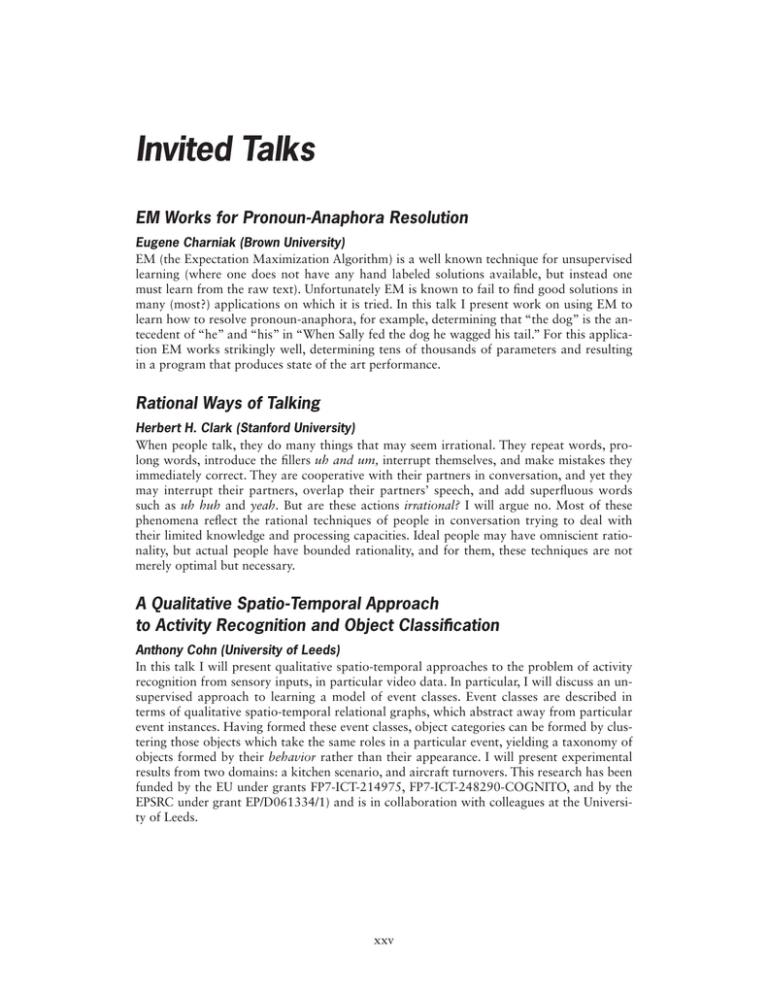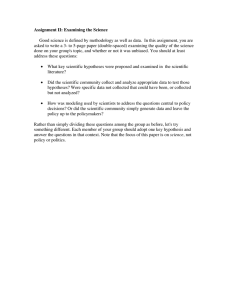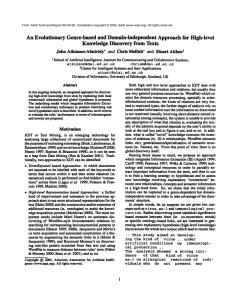Invited Talks EM Works for Pronoun-Anaphora Resolution
advertisement

Invited Talks EM Works for Pronoun-Anaphora Resolution Eugene Charniak (Brown University) EM (the Expectation Maximization Algorithm) is a well known technique for unsupervised learning (where one does not have any hand labeled solutions available, but instead one must learn from the raw text). Unfortunately EM is known to fail to find good solutions in many (most?) applications on which it is tried. In this talk I present work on using EM to learn how to resolve pronoun-anaphora, for example, determining that “the dog” is the antecedent of “he” and “his” in “When Sally fed the dog he wagged his tail.” For this application EM works strikingly well, determining tens of thousands of parameters and resulting in a program that produces state of the art performance. Rational Ways of Talking Herbert H. Clark (Stanford University) When people talk, they do many things that may seem irrational. They repeat words, prolong words, introduce the fillers uh and um, interrupt themselves, and make mistakes they immediately correct. They are cooperative with their partners in conversation, and yet they may interrupt their partners, overlap their partners’ speech, and add superfluous words such as uh huh and yeah. But are these actions irrational? I will argue no. Most of these phenomena reflect the rational techniques of people in conversation trying to deal with their limited knowledge and processing capacities. Ideal people may have omniscient rationality, but actual people have bounded rationality, and for them, these techniques are not merely optimal but necessary. A Qualitative Spatio-Temporal Approach to Activity Recognition and Object Classification Anthony Cohn (University of Leeds) In this talk I will present qualitative spatio-temporal approaches to the problem of activity recognition from sensory inputs, in particular video data. In particular, I will discuss an unsupervised approach to learning a model of event classes. Event classes are described in terms of qualitative spatio-temporal relational graphs, which abstract away from particular event instances. Having formed these event classes, object categories can be formed by clustering those objects which take the same roles in a particular event, yielding a taxonomy of objects formed by their behavior rather than their appearance. I will present experimental results from two domains: a kitchen scenario, and aircraft turnovers. This research has been funded by the EU under grants FP7-ICT-214975, FP7-ICT-248290-COGNITO, and by the EPSRC under grant EP/D061334/1) and is in collaboration with colleagues at the University of Leeds. xxv How Can We Help People Develop Their Creativity? Janet L. Kolodner (Georgia Institute of Technology) There are many systems out there that help people create more creative products. But creating products and systematically taking a creative approach to solving problems and designing are two different things. How can we help people develop more creative problem solving and design capabilities? Research on the processes involved in being creative provides some clues. So does research on helping kids learn to be scientific reasoners. In this talk, I bring the two together — using what we know about processes involved in creative reasoning and what we know about helping children learn reasoning skills to propose ways of helping people become systematically creative. I suggest a pedagogical approach (one based on what case-based reasoning suggests about promoting learning) and several types of software resources to support such learning — a special type of simulation and modeling system, a special type of case library, and software in support of story telling. What Should the World-Wide Mind Believe? Knowledge and Uncertainty at a Global Scale David Poole (University of British Columbia) Current search engines make recommendations based on popularity or appeal to authority. Scientists know that popularity and authority are not an appropriate basis for belief; our beliefs should be based on evidence. This talk outlines how publishing ontologies, data and probabilistic hypotheses/theories can let us base beliefs on evidence, and how the resulting world-wide mind can go beyond the aggregation of human knowledge. This is based on the foundations of the Semantic Web, probabilistic reasoning and machine learning. Data is published with reference to ontologies. Hypotheses that make (probabilistic) predictions on the data are also published. The hypotheses can be judged by all of the data they make predictions on. Given a query, a search engine can find the hypotheses that predict a value for the query and best fit the available evidence. By enabling people to publish observational data and hypotheses, the hypotheses that best fit the data, the theories, will be able to be used for prediction. This talk will overview the technology behind this vision and the considerable technical and social problems that remain. Data Mining, Academia and Business: Then and Now Jorge C. G. Ramirez (Apple, Inc.) As a member of various program committees for FLAIRS over the past 10 years, I have become increasingly aware of the lack of impact that the papers I review have on real world problems, and even questioned the lack of impact on the field of data mining itself. When I review a paper, I want to know what is in it for me, the scientist at a major Silicon Valley firm. What can I take away and use to improve what we do in the world of Business Intelligence? Of course, I am intrigued by innovations in data mining techniques, and, of course, I am intrigued by interesting uses of data mining for specific application domains. But realistically, lets look at what has changed since I was a presenter at FLAIRS-11 in 1998, and what does that say about the state of the data mining field today? xxvi






